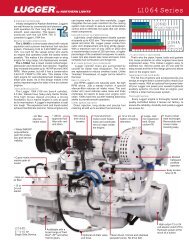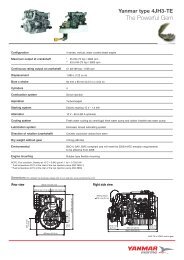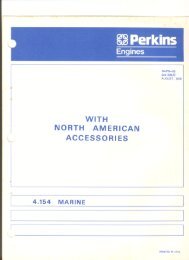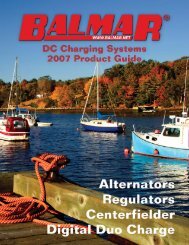The good-old Peterson 44 – After 45,000 miles
The good-old Peterson 44 – After 45,000 miles
The good-old Peterson 44 – After 45,000 miles
You also want an ePaper? Increase the reach of your titles
YUMPU automatically turns print PDFs into web optimized ePapers that Google loves.
zillions of holes and put nonskid back on.<br />
For air circulation, the P-<strong>44</strong> has 14 opening<br />
bronze ports; early boats had only 10<br />
with fixed portlights amidships and teak<br />
trim rings instead of the bronze that Zorana<br />
has. <strong>The</strong>re are three opening hatches<br />
(early boats had wood, later aluminum)<br />
and two companionways. All in all,<br />
there’s enough air flow to keep you cool<br />
in all but the stillest days. But that’s why<br />
they invented fans!<br />
<strong>The</strong> P-<strong>44</strong>s were shipped without rigs<br />
and then set up where they were, so that<br />
the California boats were usually Kenyan<br />
spars and Nav-tec rigging. Zorana, which<br />
was shipped to Germany, has Reckman/<br />
Shultz spars and Nav-tec rigging, plus<br />
special roller-furling gear built for Hood<br />
by Reckman/Shultz. <strong>The</strong> stainless-steel<br />
chainplates pass through the deck and<br />
are securely bolted to the hull/frames.<br />
Because these boats are over 18 years<br />
<strong>old</strong> now, all the bolts should be pulled,<br />
inspected, and replaced if necessary. At<br />
the same time, you should pull the genoatrack<br />
bolts and check them too.<br />
Cockpit & deck<br />
<strong>The</strong> cockpit is one of our favorite features.<br />
We enjoy warm-weather cruising<br />
and virtually live outside. <strong>The</strong> P-<strong>44</strong>’s cockpit<br />
is comfortable and secure, with over<br />
six-foot side cushions (for naps), bridgedeck<br />
forward, and our custom made propane<br />
box/helm seat aft. With a dodger and<br />
bimini with side flaps, we can enjoy most<br />
weather conditions. <strong>The</strong>re’s plenty of storage<br />
in the pukas, port and starboard, and<br />
the port seat locker is quite large. <strong>The</strong><br />
starboard seat locker opens to allow air<br />
to the walk-through for those miserable<br />
days when the engine must be attended<br />
to. <strong>The</strong> cockpit sole is a soft patch that<br />
can be removed for those major engineroom<br />
jobs.<br />
Steering is via a Yacht Specialties wheel<br />
and binnacle with cables running down<br />
the port side aft to the bronze quadrant.<br />
Despite the long run, about 20 feet, the<br />
steering feels <strong>good</strong> with normal feedback.<br />
<strong>The</strong> emergency filler fits onto the rudderpost<br />
beneath the aft bunk. This is not the<br />
best setup, and you certainly wouldn’t<br />
want to steer this way for long, so carry a<br />
spare cable.<br />
<strong>The</strong> deck layout is <strong>good</strong>, with wide side<br />
decks, high lifelines, with securelymounted<br />
stanchions and bow and stern<br />
pulpits; however, we had to move ours<br />
over to accommodate the Aires windvane.<br />
<strong>The</strong> aft deck is great <strong>–</strong> <strong>good</strong> for sun bath-<br />
ing, fishing, leaving your diving gear, and<br />
the like. We see a lot of P-<strong>44</strong> owners clutter<br />
this area up with deck lockers, life<br />
rafts and what not; they don’t know what<br />
they’re missing. <strong>The</strong>re is a teak splashguard<br />
for the dodger and a teak garage<br />
for the main hatch. Around the mast we<br />
have sissy bars, which are optional, but<br />
we love them for the security when reefing<br />
the mainsail.<br />
Rig & Sails<br />
<strong>The</strong> rig was designed for light California<br />
winds, so there is plenty of it. <strong>The</strong><br />
mast is 60 feet above the waterline, keelstepped,<br />
double-spreader with 3/8” cap<br />
shrouds, headstay and backstay. <strong>The</strong><br />
lowers and intermediates are 5/16”,<br />
forestay is 9/32”, and the running<br />
A surprisingly<br />
<strong>good</strong> sailing<br />
boat, the P-<strong>44</strong><br />
knocks off 160mile<br />
days regularly<br />
in the trade<br />
winds and can hit<br />
190 when<br />
pushed. Her long<br />
waterline means<br />
she has a high<br />
average speed<br />
for passagemaking.<br />
backstays are ¼”. Zorana’s sail inventory:<br />
356 sq. ft. mainsail, 205 sq. ft.<br />
staysail, 560 sq. ft. No. 2 genoa, app. 1400<br />
sq. ft. cruising chute, 90% yankee, and<br />
storm staysail. We had a third set of reef<br />
points put in the mainsail, and the rollerfurling<br />
No. 2 has a foam luff to help shape<br />
it when reefed. <strong>The</strong> mainsail sheeting is<br />
from the end of the 17-foot boom, which<br />
helps keep it out of the cockpit. <strong>The</strong><br />
original boats had mainsails to the end<br />
of the booms; however, this was too<br />
overpowering, so they cut the mainsail<br />
back 30 inches on the foot. We have a<br />
17’6” spinnaker pole that works great for<br />
downwind work.<br />
For sail trim, the P-<strong>44</strong> has turning<br />
blocks (we oversized ours), No. 55<br />
Lewmar self-tailing primaries, and three<br />
Custom Yacht No. 22s for mainsail and<br />
2 Blue Water Sailing






